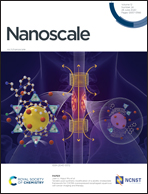A viable method to enhance the electrical conductivity of CNT bundles: direct in situ TEM evaluation†
Abstract
Carbon nanotubes (CNTs) exhibit outstanding electrical and mechanical properties, but these superior properties are often compromised as nanotubes are assembled into bulk structures, which limits the use of CNT assemblies. Despite much work in this field, few studies have made in situ observations of the relationship between electrical conductivity and the amount of nanowelding within pristine CNT assemblies at the microscopic scale. Here, we report in situ transmission electron microscopy observations of electrical conductivity increase of CNT bundles. High-temperature Joule heating was applied to a CNT bundle to fuse adjacent carbon nanofibers with graphitic carbon bonds, as this causes the electrical conductivity of the CNT bundle to increase three orders of magnitude. Apart from the welding process of the cross-over CNT bundles, we further observed a new case of welding process of parallel CNT bundles. Here, we not only obtain the relationship between electrical conductivity of CNT bundles and their merging processes, but also show the effect of the relationship between electrical conductivity and Joule-heating induced temperature on CNT bundles, which follows the natural logarithm law. Improving effective inter-bonding between neighboring nanotubes would help facilitate large-scale development of high-performing, bulk-carbon-based materials from nanostructures in applications such as flexible devices, energy storage, and electrocatalysis.



 Please wait while we load your content...
Please wait while we load your content...